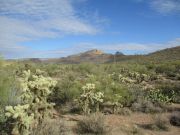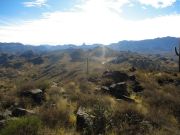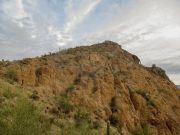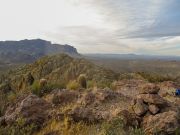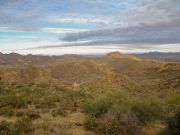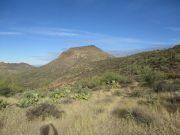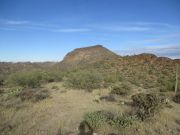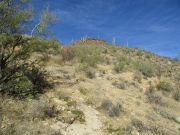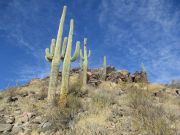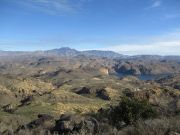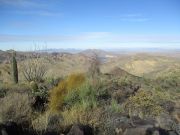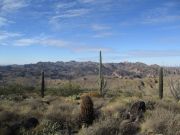
The Mountains of Arizona
• www.surgent.net
|
|
Peak 2960 (Little Four Peaks) • Peak 2881 Apache Gap is where highway AZ-88 crosses through a pass about five miles north of the Lost Dutchman State Park. Here, the highway cuts from the west-facing slopes to the east-facing slopes, and views of Canyon Lake become visible in a few spots. Two peaks --- Peak 2881 and Peak 2960 --- lie on either side of the pass and would be the agenda for this morning.
Date: December 14, 2020
• Elevation: 2,960 feet
• Prominence: 715 feet
• Distance: 2 miles
• Time: 1 hour and 15 minutes
• Gain: 620 feet
• Conditions: Overcast and cool
Arizona
•
Main
•
PB
•
LoJ
I left Payson at 6:15 a.m., cold and dark, temperature in the low 30s. I drove south toward Phoenix, but left the highway early and took the Bush Highway, Usery Pass Road, Ellsworth Road and US-60 into Apache Junction. I stopped for snacks, then drove up AZ-88 toward Peak 2960, also known as Little Four Peaks. A rock outcrop on a high ridge has an almost identical profile to the larger Four Peaks to the northeast, and at spots along the highway, the two features line up almost exactly.
By now, the sun was up, but the day was heavily overcast. I drove northbound on AZ-88 to a clearing just past Milepost 205 on the west side of the highway, and parked below some power lines. I was hiking at 7:45, the air temperature about 45 degrees. Across the highway is an inlet point for an old road that leads into a small bowl hemmed in by two ridges that come off Peak 2960's top. I followed the road in about 300 feet, then at a Y-split, went right, heading uphill. This track ends quickly, but a path continues onward from here.
The path generally stays midway up from a drainage and below the ridge crest, and is easy to follow. It is fairly well-defined and with cairns. I lost the way a coupe times but always found it again within minutes. This segment went quickly and was quite simple. The path eventually gains the ridge and curls slightly left, aiming for a saddle between the two main lobes of the summits of this peak.
A right leads south up a short rock wall and up to the Little Four Peaks ridge. A left goes north uphill through scrub and rock to the presumed summit of this peak. I went left, following faint paths and some cross-country, to gain this highpoint. The one-way hike had taken about 40 minutes, covering a mile with over 600 feet of gain.
I spent a few minutes up top, signing into the register. This hill sees a lot of visitation, one every few days during the cooler months. The views up here are fantastic, with views of Canyon Lake and the Superstition Wilderness to the east, the Superstition Mountains to the south, the Goldfield Mountains to the west and more hills and distant peaks to the north. Unfortunately, the clouds had yet to depart and I had poor lighting for photographs.
The Little Four Peaks massif lies on the southern lobe. It appears to be as high as the north summit, the one I was on now. I did not have a level to sight between the two, but I squatted down to where my head was level with the high rocks on this north summit, and the south summit was hidden. It's close, but my guess is the southern highest point is a few feet lower than the north summit.
I spent about 10 minutes up top before heading down. The outbound hike went fast. Once back on the tracks, I met a couple hiking up. The man has been here before, and we had a short talk. I was back to my car a little before 9 a.m..
Most topographical maps show the two summits each within a 2,920-foot contour. One mapper site lists an elevation of 2,957 feet for the north summit, while one older map shows a small 2,960-foot contour at this northern summit. This may indicate a general belief the mappers agree the north summit is higher. My own visual inspection told me that it is close, but "probably" the north summit is higher by a small amount. For purposes of this site, I use the 2,960-foot figure. I did not hike this southern summit, sensing some of the rock at the top may be too much for me. The 2,960-foot top also happens to be a waypoint on the boundary of the Superstition Wilderness.
Date: December 14, 2020
• Elevation: 2,881 feet
• Prominence: 521 feet
• Distance: 2.8 miles
• Time: 2 hours and 10 minutes
• Gain: 620 feet
• Conditions: Clearing and sunnier
PB
•
LoJ
Back to my car, I only had to drive about a half mile to a small pullout at Apache Gap Pass itself. Once parked, I was moving within minutes, crossing the highway and down an embankment to catch another old Jeep track. This track stayed low in a drainage, parallelling a ridge that comes off Peak 2881 to the southeast. I followed the track for about a third of a mile to a low pass. Here, the track bent right and uphill, emerging onto this ridge, roughly a half-mile total hiking from the highway. Suddenly, the coulds were gone and I had blue skies and great lighting for photos.
Once on the ridge, the way is obvious: aim for the peak up ahead. The going was easy, a mix of rocks, cactus and brush, and a few open lanes, some possibly even faint footpaths. I went up and down a couple bumps, and another half-mile brought me to the base of the main summit massif.
It would be impossible to explain exactly what I did, but the general approach is self-evident as one gains elevation. At the low saddle below the final slopes, there is a rock rib, and I stayed left for a short ways, then scampered up a ramp that put me on top this rib. There was a footpath here that led farther uphill, so I followed it another few dozen feet.
I had some reports from HikeArizona where most suggested that the southern slopes would be too loose and rubbly for some people's comfort, and suggested to angle right, traverse below the summit to the east, then catch the milder north ridge to the top. This was my general plan, but I also would make decisions as I gained up each segment. At first, the slopes steepened but still looked manageable --- until suddenly they were too steep and full of loose scree. So I backed down a few feet and looked around.
I crashed through a few feet of light brush and found another footpath. It was very scant but clearly a path, so I followed it. It bent east and seemed to lead up and possibly around the summit. Maybe this is what they were talking about in the reports. I gained about 50 feet then came to a rocky traverse that looked washed out.
I was about 120 feet below the summit, the top in view and enticingly close. The slope up to it looked like something I could handle. I left this footpath and started up the slope, keeping to whatever rocks I could for better footing. I gained thirty feet quickly to come to a small level portion. Then the slope steepened again. This was the short stretch run to the top. It was steep and loose, but with enough basaltic rocks on which to stand and gain surer footing. I was soon on the lower rock apron of the summit. I picked my way through the rocks, then up a ten-foot chute through the main caprock rim that fed onto the flat summit.
The register was buried in a cairn and noted some people had been here in the last ten days. With the clouds gone, I stuck around longer and took more photographs of the surrounding mountains, with views into both Saguaro and Canyon Lakes. I spent about fifteen minutes up top. The temperature was now more mild, in the high 50s, and the day was beautiful.
For the exit, I headed down the same way. The top-most slopes were slippery, so I slid on my behind for small segments and used my poles to carefuly balance in other parts. I was down the slipperiest parts quickly. Once back on the more sane slopes, I moved much faster, then once back on the long south ridge, almost jog-walked out the rest to my car. I arrived back a little before noon, changed into more comfortable clothes. I had been gone for a little over two hours. I drove out and snapped a few more photos in the better light, then headed onto campus at ASU to pick up a few things. It was my first time there in weeks.
To summarize my thoughts on this peak: The south ridge seems to be the most logical way to approach it, unless it is combined within some much-longer route coming in from the north. I just did not see a convenient way to the north ridge that wouldn't involve crossing over a few ridges or battling off-trail brush and rocks. I agree the north ridge to the top looks friendlier, but not by much. The top crown will be rubbly no matter what direction it is approached. Anyone climbing it from the south will likely figure out the details along the way. I did not feel it necessary to traverse to the north ridge, but others may feel differently.
|
|
